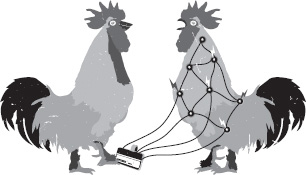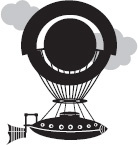Uncle John’s Bathroom Reader Weird Inventions (20 page)
Read Uncle John’s Bathroom Reader Weird Inventions Online
Authors: Bathroom Readers’ Institute

But hey! It’s a balloon! Everyone loves balloons.
N
ewspaper circulation has been falling for years, and there’s been much hand-wringing over the prospect of a less-informed public and its implications for our democracy. But there’s an overlooked consequence to the decline of print journalism.
See, even trained, full-grown dogs will sometimes have to “go” indoors, especially if the animal or the owner have health issues that make it hard to get around outside. Short of teaching the dog to use a litter box, the morning newspaper has been the best option for keeping the process sanitary, since news-print is fairly absorbent, cheap, and easily disposable. But fewer newspapers means fewer surfaces for housebound dogs to do their dirty business.
Enter the PetZoom Pet Park, an alternative for indoor dogs that brings a little slice of lawn to the living room. Retailing at about $35, the setup consists of a platform of easy-to-clean artificial turf atop an antimicrobial mat. Urine drains away and is collected in a catchbasin below, to be emptied out later. It’s convenient and hygienic, letting your dog answer the call of nature without leaving the house.
Or you could fill a child’s wading pool with 10 bucks’ worth of dirt and grass seed.

I
n 1925 magazine publisher and health nut Gaylord Wilshire unveiled his invention, the I-ON-A-CO Electric Belt. Wilshire claimed that this seemingly revolutionary device could cure heart disease, all cancers, both types of diabetes, prostate issues, and any other illness he forgot to mention. How? Worn properly, the belt sent a mild jolt of electricity coursing through the body, which Wilshire said magnetized the iron in the blood, shocking the cells into behaving properly. “All you have to do,” one ad read, “is to place over your shoulders the I-ON-A-CO. That’s all. You may then light a cigarette and read your newspaper for 10 or 15 minutes.”
Wilshire claimed that the belt could even cure medical ailments after a single application. This, and all the other claims, attracted the attention of the American Medical Association, the Public Health League, and the Better Business Bureau, among other watchdog organizations. After a scientific study, the AMA announced that the I-ON-A-CO was about as helpful in curing illness as “the left hind foot of a rabbit caught in a churchyard in the dark of the moon.” Wilshire died just two years later. (The I-ON-A-CO belt evidently did not cure death.)

F
or most of us, cockfighting is a fringe phenomenon with a funny name, and the exclusive domain of degenerate gamblers in back alleys betting on battles between birds. The truth is, though, that it’s one of the world’s oldest spectator sports. And while it’s illegal in all 50 states, underground cockfighting is still popular enough to draw the attention of law enforcement throughout the country. All of which is to say that we admit that the existence of a patented non-lethal cockfighting system is a very good thing.
In fact, this gadget—which swaps out the deadly knives known as “gaffs” that roosters wear in traditional cockfighting for an array of sensors that record the blows landed by an enemy bird—probably has more chicken-lifesaving potential than any other weird invention in this book. And given that it uses technology no more complicated than your average garage-door opener, it seems safe to assume it could be mass-produced relatively cheaply.
M
ost weird and pointless inventions come about because of accidents, opportunism, or general greed, but one of the weirdest and most pointless inventions of them all was born of genuine strife and ennui. Ken Ahroni always looked forward to the tradition of breaking the wishbone after a Thanksgiving meal. The problem? There’s only one wishbone per turkey, and it takes a mere two people to break it, so Ahroni often had to share the honor. One year, while seething over the injustice, his mind snapped like so many sad, brittle turkey clavicles. Unwilling, nay,
unable
to take it anymore, Ahroni started Lucky Break, a company devoted to the manufacture of plastic wishbones.
Lucky Break’s artificial wishbones are exactly what they sound like: cheap little white pieces of plastic that look like turkey bones. You pay money for them, snap them in half, and then immediately throw them in the garbage. Now, we’ve already established that the inventor of such a product must be sort of a loon, but Ahroni is not to be trifled with: In 2008 he successfully sued Sears, Roebuck & Co. for stealing his idea. Big-timey lawyers for Sears hilariously argued that “any originality inherent in a replica of a wishbone was invested so by nature, by a supreme being, or by the turkey itself.” In the ultimate lucky break, Ken won out to the tune of $1.7 million.
ACT NOW! SUPPLIES ARE LIMITED!
The best stuff ever advertised on late-night TV
.
T
he Thighmaster.
Sitcom star Suzanne Somers helped revive her sagging career by becoming a spokeswoman for this odd, butterfly-shaped exercise device. A series of infomercials featured the blonde bombshell using the ThighMaster and extolling the benefits of “squeezing your way to shapelier hips and thighs!” Late-night talk show hosts like David Letterman loved mocking the silly device, but Somers laughed all the way to the bank. Over 10 million Thigh-Masters have been sold to date.
The Rejuvenique Electrical Facial Mask.
This one’s definitely the weirdest product on our list. The Rejuvenique was a motorized mask that debuted in 1995 and was hawked on late-night TV by former
Dynasty
star Linda Evans. Powered by a 9-volt battery, it supposedly gave users a “facial workout” comparable to eight sit-ups, or “face-ups,” as the ads called them. Those willing to wear the mask (which made them look like the love child of C-3PO and Hannibal Lecter) for 15-minute intervals, three to four times a week, were supposedly rewarded with a more youthful-looking face. It should come as no surprise that the Rejuvenique was the subject of an FDA investigation in the early 2000s.
The Flowbee.
A San Diego carpenter created this “haircut vacuum attachment” in the late ’80s and started selling them out of his garage, marketing it to families fed up with the high cost of professional haircuts. The rather ridiculous Flowbee caught on after appearing in a series of infomercials, but it’s been widely panned by barbers and users alike. The problem: The device just isn’t very good at cutting hair—it did only one style of haircut (and sucked up the cut hair), somewhere between a bowl cut and a pageboy, a look that is neither flattering nor hip. It became a national joke in the ’90s, popping up in numerous TV shows and films like
Wayne’s World
, which featured a parody version called the Suck Kut. (Inventor: “As you can see, it sucks as it cuts.” Wayne: “It certainly does suck.”) Nevertheless, over two million Flowbees were sold by 2000.
The Tiddy Bear.
It took decades, but someone
finally
came up with a way to prevent “shoulder pain” caused by seat belts. While that’s the alleged purpose of the Tiddy Bear, its name, and the voluptuous models featured in ads for the goofy product, suggest otherwise. The bear is, more or less, a Beanie Baby with a strap that fits over a seat belt, thus allowing for a more comfortable commute (if you happen to be a lady or a particularly buxom bloke). Talk show host Ellen DeGeneres once declared the Tiddy Bear “one of the best inventions I have ever found.”
T
he flying saucer: It’s not just for aliens, by aliens! In the 1920s, American physicist Thomas Townsend Brown was studying the use of gravitational fields as a means of propulsion—in other words, using the power of gravity to make things go. He found that when he charged a capacitor to a high voltage, it moved toward its positive pole, creating an “ion wind.” He claimed that this effect proved a link between electrical charge and gravitational mass, and argued that it could be harnessed to create flight, seemingly free of both the strictures of mainstream physics and the need for gasoline.
In 1953 Brown demonstrated his “electrogravitic” propulsion for the U.S. Army at Pearl Harbor by flying a pair of metal disks around a 50-foot course. Energized by 150,000 volts, the disks, which were three feet in diameter, reached speeds of several hundred miles per hour. According to Brown, the military immediately classified the project and no more was heard about it. But throughout the 1950s, Brown’s work was cited as a possible explanation for how UFOs might be able to fly.

FANCY MAN MUSTACHE ACCESSORIES
T
he Mustache Cup and Glass.
Patented by a man named Albert Schenck in 1879, this strange invention was designed to keep ’staches out of hot drinks. Picture a children’s sippy cup crossbred with a coffee mug. In addition to a side chamber that allowed liquid to pass into the drinker’s mouth, it also contained a miniature shelf on the top to keep facial hair out of the way.
The Mustache Guard.
This one was created by Ruben P. Hollinshead in 1890 and was intended to help fanciful lads with mustaches eat meals. The guard, which sort of resembled a metallic bow tie, slipped over a gentleman’s facial hair and was held in place with strings that fitted around the ears. While practical, and capable of keeping a ’stache from getting in the way of spoonfuls of delicious soup, it was probably incredibly uncomfortable to wear.
The Mustache Trainer.
This harebrained device, invented by Louis Auguste Allard in 1889, looked like a cruel dental appliance. Supposedly, it allowed the wearer to “train” his mustache and make it grow in a “desired form and position” with the use of hooks. Needless to say, the trainer wasn’t very good at helping men grow anything other than painful facial welts.
I
n 1998, Dr. Claude Rossel opened his private clinic, Centre Biotonus Clinique Bon Port, with the intention of taking both the physical health and mental balance of patients into account. For those who can’t afford to pop over to Switzerland at the drop of a hat, however, the clinic has designed the Relaxman Relaxation Capsule.
If you’re stressed out about your stress levels, finding yourself increasingly desperate to unwind, and—we really can’t stress this particular bit enough—you have $50,000 lying around, then you could do a lot worse than spending it on a Relaxman. Purportedly soundproof, lightproof, and heatproof, the capsule features a water mattress that remains heated to body temperature and plays pre-programmed music to soothe whatever savage beast lies down inside.
The advertisement for the Relaxman cites source-free research that conveniently shows that “a 50-minute rest in the negative ion-enriched atmosphere effectively helps reduce tension, anxiety, depression, and fatigue.” The capsule is also supposedly pretty good for fixing folks’ jet lag and sleep imbalance, as well it should be.